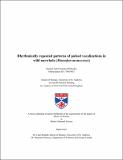Rhythmically repeated patterns of pulsed vocalizations in wild narwhals (Monodon monoceros)
Abstract
Sequences of vocalizations are indicative of communicative complexity. However, relative to
birds and terrestrial mammals, the extent to which marine mammals use vocal sequences is not
well understood. I provide the first investigation into vocal sequences in narwhals (Monodon
monoceros), a gregarious Arctic cetacean.
Eight female narwhals were fitted with animal-borne recording devices, resulting in one
of the largest datasets of narwhal acoustic behaviour to date. I used a combination of visual and
quantitative classification procedures to rigorously demonstrate stereotyped organizational
properties of subjectively defined sequence types. Next, acoustic characteristics were used to
generate coarse inferences regarding patterns of sequence use across individuals. Finally, I used
generalized linear models (GLMs) to assess the behavioural and acoustic contexts under which
sequences were produced.
I identified two types of sequences: “paired” patterns, consisting of combinations of two
stereotyped click-based calls, the pair of which were often repeated in rapid succession. While
these calls were rare, I found multiple subtypes that were predominantly associated with
recordings from specific tags. I secondly identified “burst pulse series”, temporally stereotyped
sets of short burst-pulses which themselves were combined into repetitive vocalization events. I
found few links between sequence use and behaviour, though burst-pulse series were more likely
to be produced in periods when other vocalizations were heard, suggesting possible use in social
contexts.
These findings extend the set of odontocetes which are known to use sequences of
vocalizations. Both sequence types show rhythmic repetition of lower-level patterns, suggestive
of hierarchical organizational principles. Furthermore, paired patterns constitute the first evidence
of multi-unit sequences in the family Monodontidae. I propose that further inquiry into vocal
sequences in narwhals and other understudied marine mammals is warranted.
Type
Thesis, MSc Master of Science
Collections
Items in the St Andrews Research Repository are protected by copyright, with all rights reserved, unless otherwise indicated.

